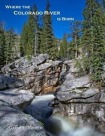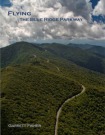Yellowstone by Air in the Freezing Winter
Story and photos by Garrett Fisher
Flying over a closed Yellowstone Park in the dead of winter, the pilot of a 1940s plane with no heat balances a high level of danger with the joy of seeing nature's untouched splendor.

As I pulled the propeller over, I could feel the fatigue in the engine. On the first crank, the engine is dry, having sat overnight in cool hangar, worsened now as I pulled the airplane out into below-zero temperatures. The second crank, I begin to feel the jelly-like oil lubricate the almost 50-year old engine. As usual, the reliable airplane starts on the third crank with a shudder, echoing down a cold airframe that groans, asking me why I am making her fly this morning. I crawl in as fast as I can and shut the door, my breath filling up the windshield. There is no heat, and I'll be here for fifteen minutes as the engine's sounds slowly transition from painful awkwardness to a smooth purr while it warms up enough to take off.

Photo by Adam Romer
I am entranced in some strange thoughts on this particular morning. Normally, the weather is more humane, and I am not sitting like a polar bear with double ski gear waiting for the airplane to be ready for take-off; I am in the air, eliminating any opportunity to think too deeply about the plan ahead, focused instead on the coming battle with the sky.
Liftoff this morning happens gracefully, below zero air being extremely dense and very stable. Reaching the end of the runway, I cross over into Idaho while making a graceful arcing turn to the east, plotting my course against the Snake River.
The Snake River has its headwaters in Yellowstone National Park, at the continental divide in the southeastern corner of the park, taking a course that will cross through the plains of Idaho, emptying into the Columbia in Washington State, which will then empty into the Pacific Ocean. This water will irrigate farms that grow America's potatoes, pass through barren desert, power immense hydroelectric dams, and provide the medium for salmon to attempt to swim home. As I enter the Snake River Canyon in Wyoming, I am not concerned with where the water is going; I am concerned with the terrain where it comes from. The water is flowing the opposite direction as I fly east and then north.

Entering Jackson Hole, the Snake River heads off to my left, and I go straight. Its something I have always done coming through here, attracted to the beautiful hills around town. I fly, over the National Elk Refuge, enjoying some of the finest views of the Tetons, flying about one thousand feet above the valley floor, slaloming around terrain. Today I am looking at eye level into some of the most expensive homes in America as I cruise at hilltop level en route to open spaces.
There is a six-mile diameter circle of airspace that surrounds Jackson Hole Airport north of town. It stretches from the valley floor at 6,300 feet above sea level to the air up to 8,900 feet, a modest chunk of atmosphere where I must ask permission before flying in it. For months, I have passed to the left, right, and over this imaginary, yet very real area of planet Earth, avoiding talking to air traffic control unless I wish to land there. Out of the total percentage of atmosphere available to me within a tank of fuel in this airplane, the amount where I must ask permission is so small it is absurd to be considered a problem, yet my grandfather's words ring in my mind: "I kind of like how the crows fly. They don't care what country they are in or what the airspace is. They do what they want." Today, however, Grand Teton, at 13,770 feet, is showing herself with a resplendency that is hard to put to words. Recent snowfall has covered the entire mountain range, and overnight lows well below zero have encrusted the eastern glaciated slopes of my favorite mountain with a heavy layer of rime ice.

My overwhelming awe is tempered with a moment of reflective sadness. In two weeks, the airplane will be disassembled, packed into a shipping container with all of my belongings, and sent to Germany. This moment isn't something I can repeat at will any longer.
I decide to fly over Blacktail Butte for the first time, having avoided it beforehand because I had to talk to someone to get permission. Grand Teton lies behind the butte in resplendent beauty, providing a stunning foreground as I take pictures like I am a photographer at a Paris fashion show.
Eventually, Grand Teton passes me by, as does Mt. Moran, an imposing mountain set behind Jackson Lake. The Snake River and I meet again as we both head north. Seeing a layer of what looks like fog ahead on the horizon, I decide that now is a good time to try a position report for my flight plan. Casper Radio has trouble hearing me, though notes time and position.
Flying Over an Empty Yellowstone
This is the third time I have filed a flight plan in my life, and the first time I have done so for safety purposes. I am heading into Yellowstone. The park is the size of Delaware and Rhode Island combined, is at 8,000 feet above sea level, and is closed. There are no tourists on the roads, no hordes of backpackers, no one to see a plane go down, almost no cell reception, and no snowmobilers are allowed in the park this early in the winter.

Temperatures are below zero and the ground is covered in heavy snow. Yellowstone is as quiet and inaccessible as it will ever be, and I am heading to one of the most roadless sections of the park and the Continental United States. Nearby airports are closed for the winter or out of fuel, making Jackson Hole the nearest option in the event anything goes wrong, a sobering thought as it will end up being 45 minutes away by air.
As I approach the park, I bid the last car on the road below me goodbye, plunging into complete wilderness, in all directions, as far as the eye can see, and I am in an airplane on the clearest day one can imagine. I can see Wyoming, Idaho, and Montana simultaneously, and all of these sights I can see on the horizon in these three states are still in Yellowstone. I try another call to Casper Radio to make a position report. Silence. The Absaroka Range is blocking the radio signal.
The Snake River makes a sharp turn to the east toward its headwaters and I follow. Tucked beneath remaining wisps of fog that have risen some hundreds of feet above the ground, I pass Mt. Sheridan on my left, and Huckleberry Mountain on my right, emerging out from under the fog, staring at nothing but wide open expanses of roadless wilderness as far as the eye can see, ringed by mountains.
Reality tells me that I am taking a high risk. If the engine gives me trouble, I will be landing in a meadow, if I can find one, in deep snow, in bear country. At that moment, I will be reliant upon a satellite transmitter, a network of Russian and American satellites, a monitoring center in Maryland, and the public phone network.
Copyright (C) Perceptive Travel 2016. All rights reserved.
- The Naked Truth in Marrakech by Zora O'Neill
- Seeing the Great Barrier Reef Before It Dies by Michael Buckley
- Travel Book Reviews
- World Music Reviews
Books from the Author:

Buy Above the Summit: An Antique Airplane Conquers Colorado's Fourteeners at your local bookstore, or get it online here:
Amazon US
Amazon Canada
Amazon UK

Buy Where the Colorado River is Born at your local bookstore, or get it online here:
Amazon US
Amazon Canada
Amazon UK

Buy Flying the Blue Ridge Parkway at your local bookstore, or get it online here:
Amazon US
Amazon Canada
Amazon UK

